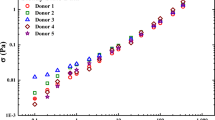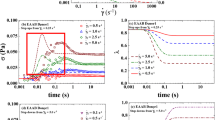Abstract
We examine the applicability of three different non-Newtonian constitutive models (power-law, Casson, and Herschel-Bulkley models) to the determination of blood viscosity and yield stress with a scanning capillary-tube rheometer. For a Newtonian fluid (distilled water), all three models produced excellent viscosity results, and the measured values of the yield stress with each model were zero. For unadulterated human blood, the Casson and Herschel-Bulkley models produced much stronger shear-thinning viscosity results than the power-law model. The yield stress values for the human blood obtained with the Casson and Herschel-Bulkley models were 13.8 and 17.5 mPa, respectively. The two models showed a small discrepancy in the yield stress values, but with the current data analysis method for the scanning capillary-tube rheometer, the Casson model seemed to be more suitable in determining the yield stress of blood than the Herschel-Bulkley model.
Similar content being viewed by others
References
S. Kim and Y. I. Cho, Effect of dye concentration on the viscosity of water in a scanning capillary-tube viscometer, J. Non-Newtonian Fluid Mech., 111 (2003) 63–68.
S. Kim, Y. I. Cho, W. N. Hogenauer and K. R. Kensey, A method of isolating surface tension and yield stress effects in a U-shaped scanning capillary-tube viscometer using a Casson model, J. Non-Newtonian Fluid Mech., 103 (2002) 205–219.
S. Kim, Y. I. Cho, A. H. Jeon, B. Hogenauer and K. R. Kensey, A new method for blood viscosity measurement, J. Non-Newtonian Fluid Mech., 1939 (2000) 1–10.
S. Kim, Y. I. Cho, K. R. Kensey, R. O. Pellizzari and P. R. Stark, A scanning dual-capillary-tube viscometer, Rev. Sci. Instrum., 71 (2000) 3188–3192.
Q. D. Nguyen and D. V. Boger, Measuring the flow properties of yield stress fluids, Annu. Rev. Fluid. Mech., 24 (1992) 47.
C. Picart, J. M. Piau and H. Galliard, Human blood shear yield stress and its hematocrit dependence, J. Rheol., 1 (1998) 42.
H. A. Barnes, The yield stress-a review-everything flows?, J. Non-Newtonian Fluid Mech., 81 (1999) 133.
S. Chakravarty, A. Datta, Dynamic Response of stenotic blood flow in vivo, Mathl. Comput. Modelling, 16 (1992) 3–20.
W. L. Siauw, E. Y. K. Ng and J. Mazumdar, Unsteady stenosis flow prediction: a comparative study of non-Newtonian models with operator splitting scheme, Medical Engineering & Physics, 22 (2000) 265–277.
C. Tu and M. Deville, Pulsatile flow of non-Newtonian fluids through arterial stenoses, J. Biomechanics, 29 (1996) 899–908.
D. Liepsch and S. Moravec, Pulsatile flow of non-Newtonian fluids in distensible models of human arteries, Biorheology, 21 (1984) 571.
K. Rohlf and G. Tenti, The role of the Womersley number in pulsatile blood flow a theoretical study of the Casson model, J. Biomechanics, 34 (2001) 141–148.
J. C. Misra and S. K. Ghosh, Flow of a Casson fluid in a narrow tube with a side branch, International Journal of Engineering Science, 38 (2000) 2045–2077.
J. C. Misra and S. K. Pandey, Peristaltic transport of blood in small vessels: Study of a mathematical model, Computers and Mathematics with Applications, 43 (2002) 1183–1193.
B. Das, R. L. Batra, Non-Newtonian flow of blood in an arteriosclerotic blood vessel with rigid permeable walls, J. Theor. Biol., 175 (1995) 1–11.
R. K. Dash, G. Jayaraman and K. N. Mehta, Estimation of increased flow resistance in a narrow catheterized artery-A theoretical model, J. Biomechanics, 29 (1996) 917–930.
J. C. Misra and B. K. Kar, A mathematical analysis of blood flow from a feeding artery into a branch capillary, Mathl. Comput. Modelling, 15 (1991) 9–18.
S. Chakravarty and A. Datta, Effects of stenosis on arterial rheology through a mathematical model, Mathl. Comput. Modelling, 12 (1989) 1601–1612.
S. Chakravarty and A. Datta, Dynamic Response of arterial blood flow in the presence of multistenoses, Mathl. Comput. Modelling, 13 (1990) 37–55.
R. Busse, I. L. Megson and P. G. Wright, Diffusion of ntric oxide and scanvenging by blood in the vasculature, Biochimica et Biophysica Acta, 1425 (1998) 168–176.
A. Koller and G. Kaley, Prostaglandins mediate arteriolar dilation to increase blood flow velocity in skeletal microcirculation. Cir. Res., 67 (1990) 529–534.
S. K. Samijo, J. M. Willigers, R. Barkhuysen, P. J. E. H. M. Kitslaar, R. S. Reneman and P. J. Brands, Wall shear stress in the human common carotid artery as function of age and gender, Cardiovascular Research, 39 (1998) 515.
Author information
Authors and Affiliations
Corresponding author
Additional information
This paper was recommended for publication in revised form by Associate Editor Gihun Son
Sangho Kim received his B.S. degree in Mechanical Engineering from Kyung-Pook National University in 1997. He then received his Ph.D. from Drexel University, USA, in 2002. Dr. Kim is currently an Assistant Professor in the Division of Bioengineering and the Department of Surgery at the National University of Singapore in Singapore.
Dohyung Lim received B.S. and M.S. degrees in Biomedical Engineering from Inje University, Kimhae, Korea, in 1998 and 2000, respectively. He then went on to receive his Ph.D. from the School of Biomedical Engineering, Science, & Health Systems, Drexel University, Philadelphia, PA, USA, in 2004. Dr. Lim completed a postdoctoral fellowship in the Department of Physical Therapy and Human Movement Science, Feinberg School of Medicine, Northwestern University, Chicago, IL, USA and was a Research Professor of Biomedical Engineering, Yonsei University, Wonju, Gangwon, Korea. Dr. Lim is currently a Senior Researcher at the Korea Institute of Industrial Technology in Cheonan, Chungnam, Korea.
Rights and permissions
About this article
Cite this article
Kim, S., Namgung, B., Ong, P.K. et al. Determination of rheological properties of whole blood with a scanning capillary-tube rheometer using constitutive models. J Mech Sci Technol 23, 1718–1726 (2009). https://doi.org/10.1007/s12206-009-0420-6
Received:
Revised:
Accepted:
Published:
Issue Date:
DOI: https://doi.org/10.1007/s12206-009-0420-6




